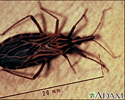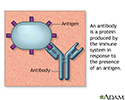Chagas disease
Parasite infection - American trypanosomiasis
Chagas disease is an illness caused by tiny parasites and spread by insects. The disease is common in South and Central America.
Causes
Chagas disease is caused by the parasite Trypanosoma cruzi. It is spread by the bite of reduviid bugs, or kissing bugs, and is one of the major health problems in South America. Due to travel and immigration, the disease also affects people in the United States.
Risk factors for Chagas disease include:
- Living in a hut where reduviid bugs live in the walls
- Living in Central or South America
- Poverty
- Receiving a blood transfusion or an organ donation from a person who carries the parasite, but does not have active Chagas disease
Symptoms
Chagas disease has two phases: acute and chronic. The acute phase may have no symptoms or very mild symptoms, including:
- Fever
- General ill feeling
- Swelling of an eye if the bite is near the eye
- Swollen red area at the site of the insect bite
After the acute phase, the disease goes into remission. There may be no other symptoms for many years. When symptoms finally develop, they may include:
- Constipation
- Digestive problems
- Pain in the abdomen
- Swallowing difficulties
- Pounding or racing heart
- Heart failure
Exams and Tests
A physical exam can confirm the symptoms. Signs of Chagas disease may include:
- Disease of the heart muscle
- Enlarged liver and spleen
- Enlarged lymph nodes
- Irregular heartbeat
- Rapid heartbeat
Tests include:
- Blood culture to look for signs of infection
- Chest x-ray
- Echocardiogram (uses sound waves to create pictures of the heart)
- Electrocardiogram (ECG, tests electrical activity in the heart)
- Enzyme-linked immunoassay (ELISA) to look for signs of infection
- Blood smear to look for signs of infection
Treatment
The acute phase of reactivated Chagas disease should be treated. Infants born with the infection should also be treated.
Treating the chronic phase is recommended for children and most adults. Adults with chronic phase Chagas disease should talk to their health care provider to decide whether treatment is needed.
Two medicines are used to treat this infection: benznidazole and nifurtimox.
Both medicines often have side effects. The side effects may be worse in older people. They may include:
- Headaches and dizziness
- Loss of appetite and weight loss
- Nerve damage
- Problems sleeping
- Skin rashes
Outlook (Prognosis)
About one third of infected people who are not treated will develop chronic or symptomatic Chagas disease. It may take more than 20 years from the time of the original infection to develop heart or digestive problems.
Abnormal heart rhythms may cause sudden death. Once heart failure develops, death usually occurs within several years.
Possible Complications
Chagas disease can cause these complications:
- Enlarged colon
- Enlarged esophagus with swallowing difficulty
- Heart disease
- Heart failure
- Malnutrition
When to Contact a Medical Professional
Contact your provider for an appointment if you think you may have Chagas disease.
Prevention
Insect control with insecticides and houses that are less likely to have high insect populations will help control the spread of the disease.
Blood banks in Central and South America screen donors for exposure to the parasite. The blood is discarded if the donor has the parasite. Most blood banks in the United States began screening for Chagas disease in 2007.
References
Kirchoff LV. Chagas disease. In: Goldman L, Cooney KA, eds. Goldman-Cecil Medicine. 27th ed. Philadelphia, PA: Elsevier; 2024:chap 318.
Kirchhoff LV. Trypanosoma species (American trypanosomiasis, Chagas' disease): biology of trypanosomes. In: Bennett JE, Dolin R, Blaser MJ, eds. Mandell, Douglas, and Bennett's Principles and Practice of Infectious Diseases. 9th ed. Philadelphia, PA: Elsevier; 2020:chap 276.
Salvana EMT, Salata RA. American Trypanosomiasis (Chagas Disease; Trypanosoma cruzi). In: Kliegman RM, St. Geme JW, Blum NJ, et al, eds. Nelson Textbook of Pediatrics. 22nd ed. Philadelphia, PA: Elsevier; 2025:chap 333.
Review Date: 11/10/2024

















